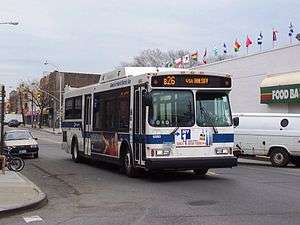B26 (New York City bus)
The Putnam Avenue Line is a public transit line in Brooklyn, New York City, running mostly along Fulton Street, Putnam Avenue, and Halsey Street between downtown Brooklyn and Ridgewood, Queens. Originally a streetcar line, it is now the B26 Halsey/Fulton Streets bus route, operated by the New York City Transit Authority.
b26 | |||
|---|---|---|---|
| Fulton Street Line | |||
 A bus on the B26 line arrives at the Ridgewood terminal. | |||
| Overview | |||
| System | MTA New York City Bus | ||
| Operator | New York City Transit Authority | ||
| Garage | Fresh Pond Depot | ||
| Route | |||
| Locale | Brooklyn | ||
| Start | Downtown Brooklyn – Cadman Plaza West and Tillary Street | ||
| Via | Fulton Street, Halsey Street[1] | ||
| End | Ridgewood, Queens – Wyckoff Avenue and Palmetto Street | ||
| Length | 6.3 miles (10.1 km)[2] | ||
| Service | |||
| Operates | All times[1] | ||
| Annual patronage | 2,920,409 (2017)[3] | ||
| Transfers | Yes | ||
| Timetable | B26 | ||
| |||
Route description
The B26 bus route begins at the Jay Street–MetroTech subway station in Downtown Brooklyn, connecting with the New York City Subway's A, C, F, <F>, and R trains. It heads east on Fulton Street, turning off onto Putnam Avenue, and uses Nostrand Avenue (eastbound) and Bedford Avenue (westbound) to reach Halsey Street. Just before the Queens border, the route turns northwest on Wyckoff Avenue, ending with a loop at the Myrtle–Wyckoff Avenues subway station (L and M trains) counterclockwise via Putnam Avenue, Myrtle Avenue, and Wyckoff Avenue. Along the way, passengers can transfer to the subway at DeKalb Avenue (B, Q, and R trains), Clinton–Washington Avenues (C train), and Halsey Street (J train).[4]
History
The Brooklyn City Rail Road opened a branch of their Fulton Street Line along Putnam Avenue, Nostrand Avenue, and Halsey Street to Broadway by 1874.[5] By 1897, cars could also use a short spur along Howard Avenue from Halsey Street north to Broadway.[6] The line was extended northeast past Broadway on Halsey Street to the Queens County line and northwest on Wyckoff Avenue to Ridgewood after 1897.
Putnam Avenue horse cars were replaced with electric trolleys on July 17, 1893.[7]
Buses were substituted for streetcars on September 21, 1941, but the line was converted back to streetcars between November 29, 1942 and February 5, 1950.[8]
In January 1995, the B26 was extended from Adams Street and Johnson Street to a new terminal at Cadman Plaza West and Tilllary Street to eliminate operational problems. To access the terminal at Adams, the B26 used a cut through the median separating the main and service roads of Adams Street, which was dangerous for buses to traverse. In addition, the terminal was congested with illegal parking, the park at the terminal was considered unsafe at night, there was no bus dispatcher at the terminal, and as passengers traveling to the Court Street/Montague Street area had to cross eight-lane Adams Street. At the new terminal, illegal parking was less of a problem, the area was safer, and because the B26 would share a terminal with the B38 and B52, the bus dispatcher assigned to those routes could also do so for the B26.[9]
References
- MTA Regional Bus Operations. "B26 bus schedule" (PDF).
- "Downtown Brooklyn Surface Transit Circulation Study" (PDF). 2009. Retrieved July 13, 2018.
- "Facts and Figures". mta.info. August 28, 2011. Retrieved July 13, 2018.
- "Brooklyn Bus Map" (PDF). Metropolitan Transportation Authority. November 2017. Retrieved April 24, 2018.
- J.B. Beers and Company, Brooklyn, 1874 (with Brooklyn City Rail Road lines overprinted)
- Rand McNally, Brooklyn and vicinity, 1897 Atlas of the World
- "How the New Tax is Levied". Brooklyn Daily Eagle. July 17, 1893. p. 10.
- "New Bus Line in Brooklyn" (PDF). The New York Times. February 5, 1950. Retrieved November 7, 2016.
-
- NYC Transit Committee Agenda September 1994. New York City Transit. September 16, 1994. pp. D.46.
- NYC Transit Committee Agenda September 1994. New York City Transit. September 16, 1994. pp. D.47.
- NYC Transit Committee Agenda September 1994. New York City Transit. September 16, 1994. pp. D.48.
- NYC Transit Committee Agenda September 1994. New York City Transit. September 16, 1994. pp. D.49.
- NYC Transit Committee Agenda September 1994. New York City Transit. September 16, 1994. pp. D.50.
